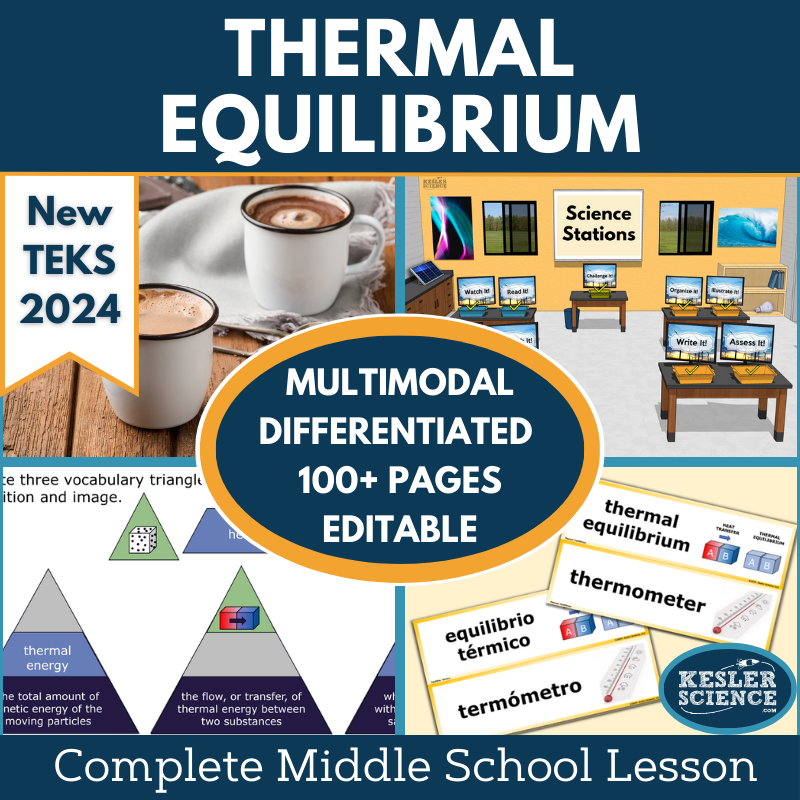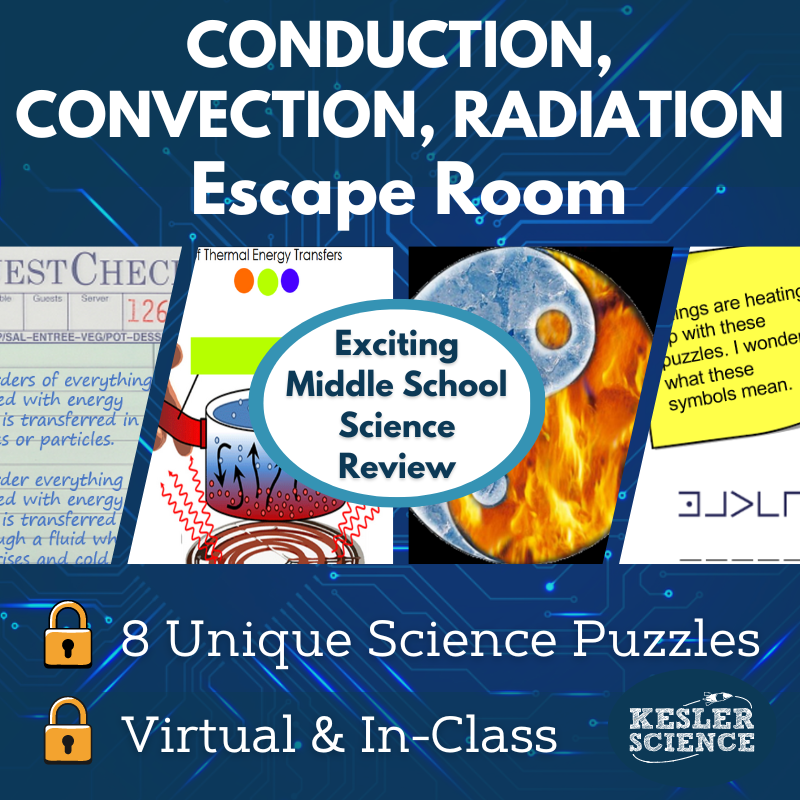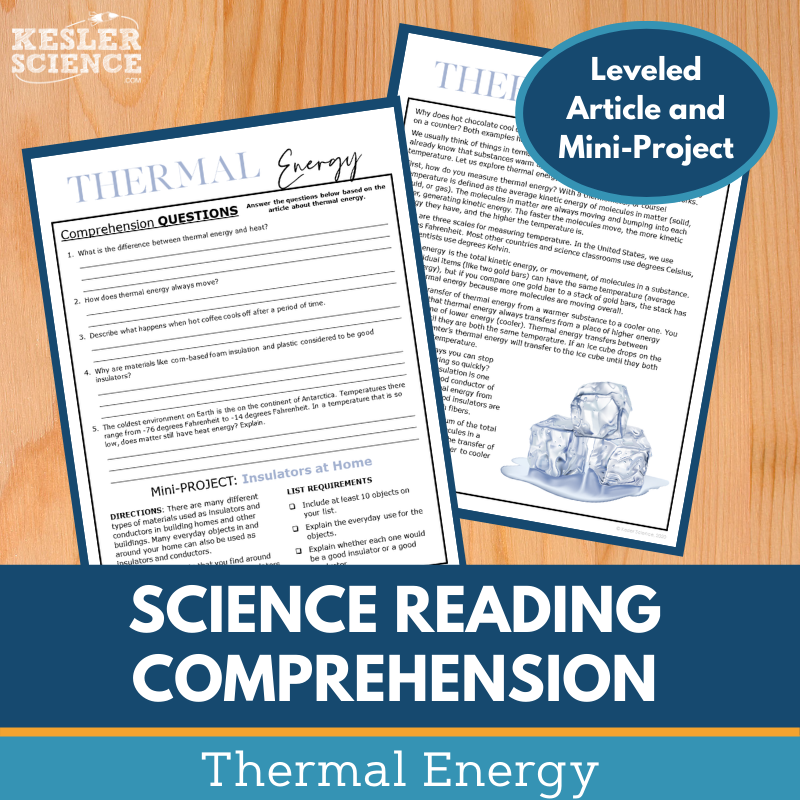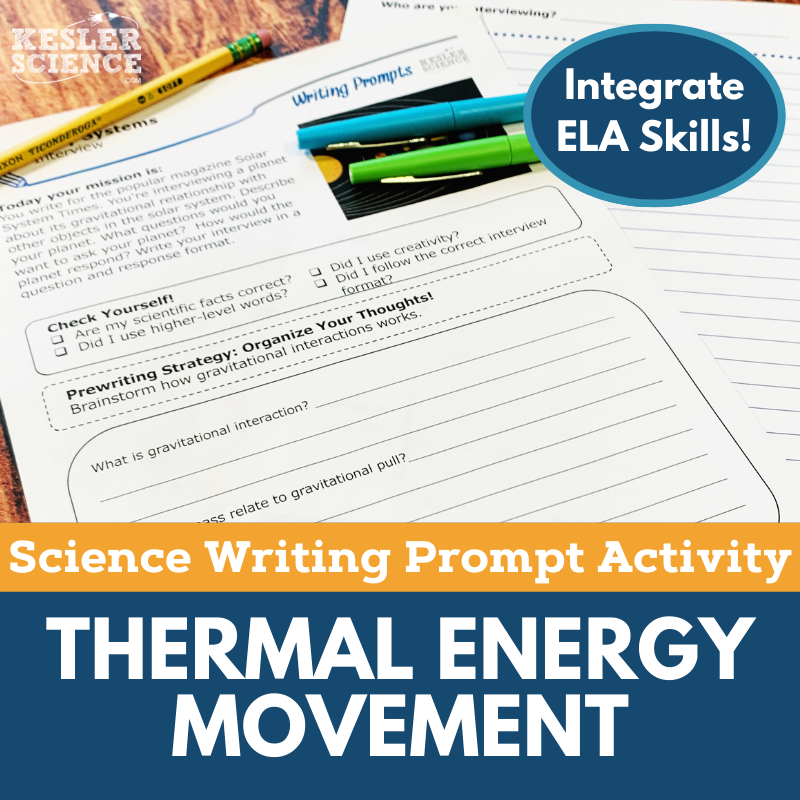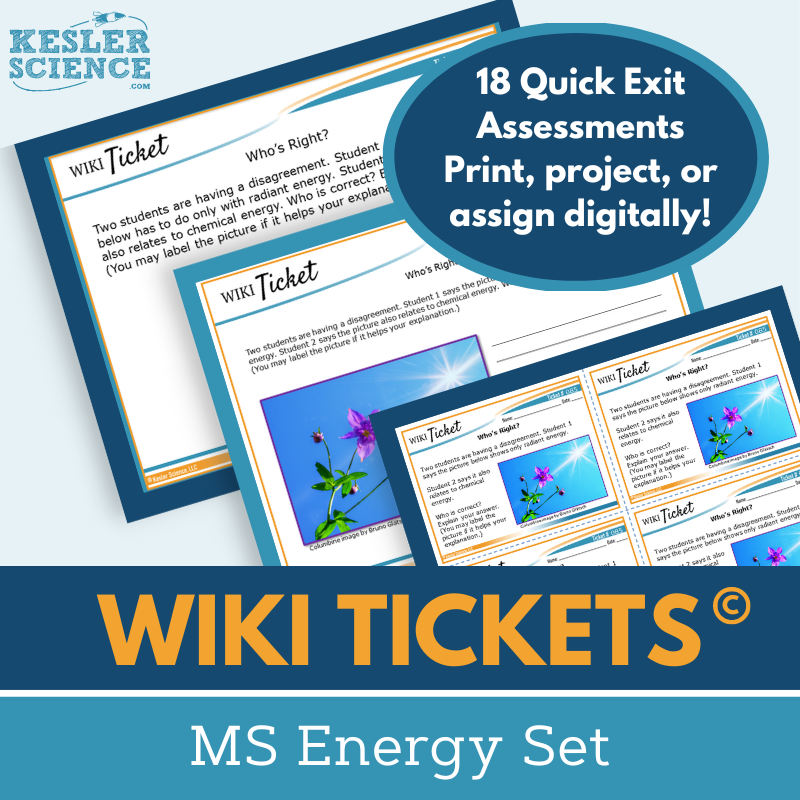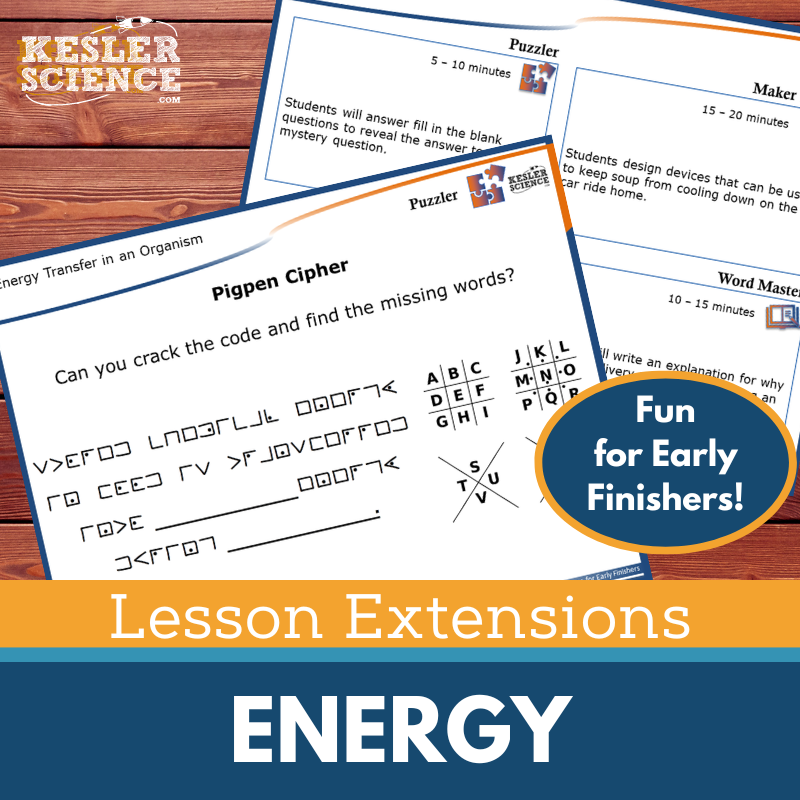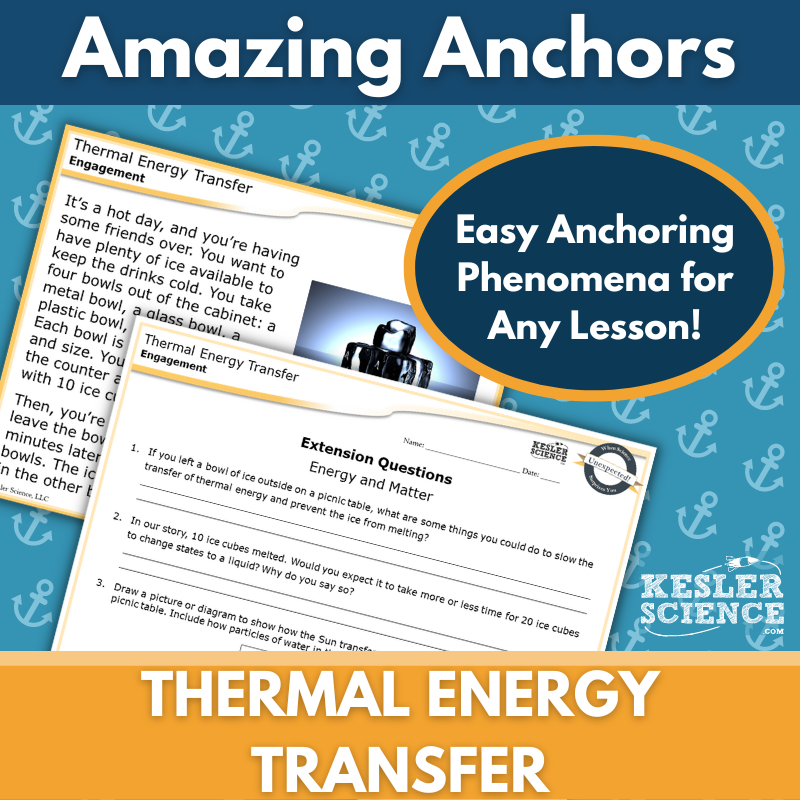Thermal Equilibrium Activities for Middle School Science
This energy unit helps middle school students understand how thermal energy moves from warmer to cooler substances until thermal equilibrium is achieved. The resources below will give students a comprehensive understanding of thermal equilibrium. All of the following materials are also included in the Kesler Science Membership.
This energy unit for middle school students focuses on how thermal energy moves from warmer to cooler substances until thermal equilibrium is reached. The lesson includes editable presentations, worksheets, choice projects, and assessments, all designed for student-led, differentiated learning. It aligns with the 2021 TEKS standard 7.8B and requires minimal prep.
Students explore key questions like "How does thermal energy move?" and "What is thermal equilibrium?" The unit is structured around the 5E Model: Engagement, Exploration, Explanation, Elaboration, and Evaluation.
During Exploration, students engage with a variety of differentiated stations that include hands-on demos, reading passages in English and Spanish, videos, and research tasks. They also demonstrate their understanding through activities like card sorts, writing, and illustrating. An optional challenge station offers enrichment for early finishers.
In Explanation, editable PowerPoints and interactive notebooks (both digital and print) support student learning. Students extend their knowledge with choice projects in Elaboration and are assessed using STAAR-aligned questions.
This flexible lesson is ideal for both in-class and virtual learning.
This energy unit for middle school students focuses on how thermal energy moves from warmer to cooler substances until thermal equilibrium is reached. The lesson includes editable presentations, worksheets, choice projects, and assessments, all designed for student-led, differentiated learning. It aligns with the 2021 TEKS standard 7.8B and requires minimal prep.
Students explore key questions like "How does thermal energy move?" and "What is thermal equilibrium?" The unit is structured around the 5E Model: Engagement, Exploration, Explanation, Elaboration, and Evaluation.
During Exploration, students engage with a variety of differentiated stations that include hands-on demos, reading passages in English and Spanish, videos, and research tasks. They also demonstrate their understanding through activities like card sorts, writing, and illustrating. An optional challenge station offers enrichment for early finishers.
In Explanation, editable PowerPoints and interactive notebooks (both digital and print) support student learning. Students extend their knowledge with choice projects in Elaboration and are assessed using STAAR-aligned questions.
This flexible lesson is ideal for both in-class and virtual learning.
This student-led activity aligns with TEKS 2021 standard 7.8B and helps students explore thermal equilibrium. Designed to engage middle school students, it allows them to investigate how thermal energy moves from warmer to cooler substances until thermal equilibrium is reached. The lesson is suitable for both in-class and virtual learning, offering a comprehensive, low-prep approach.
The station lab includes nine differentiated activities that guide students through a self-directed learning experience. Teachers facilitate rather than direct learning, and the materials are ready to use with minimal setup.
The stations include input activities like "Explore It!", where students engage with an activity or demonstration, "Watch It!", where they view a video and answer questions, "Read It!", where they read and respond to a thermal equilibrium passage, and "Research It!", where students review resources and complete related tasks. Output stations include "Organize It!", where students use manipulatives, "Illustrate It!", where they create models, "Write It!", where they answer short prompts, and "Assess It!", where they complete tasks with vocabulary in context. A bonus "Challenge It!" station offers advanced students extension activities like games and mini-projects.
This student-led activity aligns with TEKS 2021 standard 7.8B and helps students explore thermal equilibrium. Designed to engage middle school students, it allows them to investigate how thermal energy moves from warmer to cooler substances until thermal equilibrium is reached. The lesson is suitable for both in-class and virtual learning, offering a comprehensive, low-prep approach.
The station lab includes nine differentiated activities that guide students through a self-directed learning experience. Teachers facilitate rather than direct learning, and the materials are ready to use with minimal setup.
The stations include input activities like "Explore It!", where students engage with an activity or demonstration, "Watch It!", where they view a video and answer questions, "Read It!", where they read and respond to a thermal equilibrium passage, and "Research It!", where students review resources and complete related tasks. Output stations include "Organize It!", where students use manipulatives, "Illustrate It!", where they create models, "Write It!", where they answer short prompts, and "Assess It!", where they complete tasks with vocabulary in context. A bonus "Challenge It!" station offers advanced students extension activities like games and mini-projects.
The Thermal Equilibrium Student Choice Projects align with TEKS 7.8B and give middle school students the option to choose a project that matches their preferred output style. The project page offers six student-led options along with a “design your own” project. It includes an editable grading rubric that allows for assessments by teachers, peers, or students themselves.
These flexible projects support a variety of student needs. Teachers can adjust the rubric as needed, and the multimodal options provide creative ways for students to showcase their understanding. There are two versions of the project page to support differentiation: one with modified options for students needing remediation and one with challenging options for advanced learners. The projects require basic classroom supplies such as paper, markers, and scissors, with many options available for digital completion.
The Thermal Equilibrium Student Choice Projects align with TEKS 7.8B and give middle school students the option to choose a project that matches their preferred output style. The project page offers six student-led options along with a “design your own” project. It includes an editable grading rubric that allows for assessments by teachers, peers, or students themselves.
These flexible projects support a variety of student needs. Teachers can adjust the rubric as needed, and the multimodal options provide creative ways for students to showcase their understanding. There are two versions of the project page to support differentiation: one with modified options for students needing remediation and one with challenging options for advanced learners. The projects require basic classroom supplies such as paper, markers, and scissors, with many options available for digital completion.
This lab allows students to observe how temperatures change over time until they reach equilibrium, helping them understand that heat transfers from warmer to cooler environments. The lab includes three differentiated versions: a dependent lab with guided inquiry questions for on-level learners, a modified version for students needing more structure, and an independent version for advanced learners.
Materials include beakers, thermometers, graduated cylinders, water at varying temperatures, a stopwatch, and colored pencils. The resource also offers teacher pages with preparation instructions, standards, objectives, and additional resources, along with editable answer keys and Claim, Evidence, and Reasoning reflection questions for each lab.
TEKS and NGSS aligned, students investigate thermal energy transfer by focusing on modeling the effects of thermal energy on particle motion and temperature.
This lab allows students to observe how temperatures change over time until they reach equilibrium, helping them understand that heat transfers from warmer to cooler environments. The lab includes three differentiated versions: a dependent lab with guided inquiry questions for on-level learners, a modified version for students needing more structure, and an independent version for advanced learners.
Materials include beakers, thermometers, graduated cylinders, water at varying temperatures, a stopwatch, and colored pencils. The resource also offers teacher pages with preparation instructions, standards, objectives, and additional resources, along with editable answer keys and Claim, Evidence, and Reasoning reflection questions for each lab.
TEKS and NGSS aligned, students investigate thermal energy transfer by focusing on modeling the effects of thermal energy on particle motion and temperature.
The Heat Transfer Escape Room is an interactive, student-centered activity that helps students explore methods of thermal energy transfer, including conduction, convection, and radiation, in an engaging way. It aligns with TEKS standards, focusing on how thermal energy moves predictably from warmer to cooler substances. The activity also ties into NGSS standards MS PS3-4 and MS PS3-3, encouraging students to investigate energy transfer relationships and design devices that manipulate thermal energy.
The teacher has full control over the eight puzzles, choosing which ones to use and in what order, making the room adaptable to different class periods. It can be conducted with simple materials like manila envelopes or with more authentic props such as locks and a storage box for a true escape room experience. Both methods require printed materials and other tools like Frixion pens and a heat source.
The escape room is available digitally, allowing you to assign it via PowerPoint or Google Slides, and can be shared with students for home use in PDF or PPT formats. Included resources are teacher directions, answer keys, editable templates, a digital answer sheet, a video challenge, over 50 prize ideas, and unique printable props. There are also signs and templates for photo opportunities to make the experience even more memorable.
The Heat Transfer Escape Room is an interactive, student-centered activity that helps students explore methods of thermal energy transfer, including conduction, convection, and radiation, in an engaging way. It aligns with TEKS standards, focusing on how thermal energy moves predictably from warmer to cooler substances. The activity also ties into NGSS standards MS PS3-4 and MS PS3-3, encouraging students to investigate energy transfer relationships and design devices that manipulate thermal energy.
The teacher has full control over the eight puzzles, choosing which ones to use and in what order, making the room adaptable to different class periods. It can be conducted with simple materials like manila envelopes or with more authentic props such as locks and a storage box for a true escape room experience. Both methods require printed materials and other tools like Frixion pens and a heat source.
The escape room is available digitally, allowing you to assign it via PowerPoint or Google Slides, and can be shared with students for home use in PDF or PPT formats. Included resources are teacher directions, answer keys, editable templates, a digital answer sheet, a video challenge, over 50 prize ideas, and unique printable props. There are also signs and templates for photo opportunities to make the experience even more memorable.
In this lesson, students learn that thermal energy moves from warmer to cooler objects until they reach the same temperature by reading a nonfiction article on thermal energy. They complete comprehension questions and list household items that are good insulators or conductors. The passage is designed for middle school students and supports both science literacy and reading comprehension.
The resource includes two leveled articles appropriate for grades 6-8, with Lexile levels ranging from 1100 to 1300. Each article comes with 5-7 comprehension questions, a hands-on mini-project, and a Cornell notes template. Engaging graphics are provided and can be printed in grayscale. The lesson is suitable for in-person or virtual learning environments, including platforms like Google Classroom, MS Teams, and Canvas.
This resource is ideal for use with absent students, extra credit, sub plans, or whole-class instruction. It promotes classroom discussions and improves reading comprehension and science literacy.
In this lesson, students learn that thermal energy moves from warmer to cooler objects until they reach the same temperature by reading a nonfiction article on thermal energy. They complete comprehension questions and list household items that are good insulators or conductors. The passage is designed for middle school students and supports both science literacy and reading comprehension.
The resource includes two leveled articles appropriate for grades 6-8, with Lexile levels ranging from 1100 to 1300. Each article comes with 5-7 comprehension questions, a hands-on mini-project, and a Cornell notes template. Engaging graphics are provided and can be printed in grayscale. The lesson is suitable for in-person or virtual learning environments, including platforms like Google Classroom, MS Teams, and Canvas.
This resource is ideal for use with absent students, extra credit, sub plans, or whole-class instruction. It promotes classroom discussions and improves reading comprehension and science literacy.
The Thermal Energy Science Writing Prompt Activity engages middle school students in a news event-based writing exercise to reinforce their understanding of thermal energy transfer. Aligned with TEKS, this activity helps students verify through investigation that thermal energy moves predictably from warmer to cooler substances until equilibrium is reached, such as an ice cube melting. Designed for both in-person and virtual learning, this low-prep, student-centered resource supports science reasoning and writing enrichment.
This activity includes teacher directions with an answer guide, project ideas, and rubrics, as well as projection and print handouts in both full-sized and half-sheet formats. A digital interactive PowerPoint version, compatible with Google Slides, allows for easy assignment in remote or in-person settings. Ideal for cross-curricular activities, pre-test assessments, student choice projects, early finisher tasks, extra credit, make-up work, TELPAS samples, and differentiation, this writing prompt fosters engagement and scientific literacy. It can also be displayed on a bulletin board or compiled into an anthology for student collections. Note: This activity assumes students have prior knowledge of the topic or access to research materials.
The Thermal Energy Science Writing Prompt Activity engages middle school students in a news event-based writing exercise to reinforce their understanding of thermal energy transfer. Aligned with TEKS, this activity helps students verify through investigation that thermal energy moves predictably from warmer to cooler substances until equilibrium is reached, such as an ice cube melting. Designed for both in-person and virtual learning, this low-prep, student-centered resource supports science reasoning and writing enrichment.
This activity includes teacher directions with an answer guide, project ideas, and rubrics, as well as projection and print handouts in both full-sized and half-sheet formats. A digital interactive PowerPoint version, compatible with Google Slides, allows for easy assignment in remote or in-person settings. Ideal for cross-curricular activities, pre-test assessments, student choice projects, early finisher tasks, extra credit, make-up work, TELPAS samples, and differentiation, this writing prompt fosters engagement and scientific literacy. It can also be displayed on a bulletin board or compiled into an anthology for student collections. Note: This activity assumes students have prior knowledge of the topic or access to research materials.
These formative assessments for 6th-8th grade science topics offer flexible ways to check student understanding in a fun, engaging format. The Energy Set includes 18 WIKI Tickets© assessments, each available in five formats: a full-screen projection version, three print handouts (full, split, and quarter-page sizes), and a digital interactive version for PowerPoint or Google Slides. These assessments align with middle school NGSS and TEKS standards, with some topics offering multiple tickets and at least one ticket per standard. A bonus table of contents file is included to show the alignment.
WIKI Tickets© are designed for use in both in-person and virtual learning environments. Topics include energy types, calorimetry, digital and analog signals, the electromagnetic spectrum, energy transformations, photosynthesis, heat transfer, kinetic energy graphing, and more. They can be used as exit tickets, bellringers, or for gauging student progress in any learning setting, with options for digital or printed formats.
These colorful, engaging assessments are a versatile tool for checking student progress throughout the year.
These formative assessments for 6th-8th grade science topics offer flexible ways to check student understanding in a fun, engaging format. The Energy Set includes 18 WIKI Tickets© assessments, each available in five formats: a full-screen projection version, three print handouts (full, split, and quarter-page sizes), and a digital interactive version for PowerPoint or Google Slides. These assessments align with middle school NGSS and TEKS standards, with some topics offering multiple tickets and at least one ticket per standard. A bonus table of contents file is included to show the alignment.
WIKI Tickets© are designed for use in both in-person and virtual learning environments. Topics include energy types, calorimetry, digital and analog signals, electromagnetic spectrum, energy transformations, photosynthesis, heat transfer, kinetic energy graphing, and more. They can be used as exit tickets, bellringers, or for gauging student progress in any learning setting, with options for digital or printed formats.
These colorful, engaging assessments are a versatile tool for checking student progress throughout the year.
Lesson Extensions are designed to engage fast finishers with creative, critical thinking activities that align with NGSS and TEKS energy standards. They provide a fun, rigorous way to wrap up lessons, fill downtime during testing, and prevent distractions.
Each extension includes four activities: Puzzler to enhance problem-solving, Maker Space for hands-on STEAM projects, Tech Connection for digital learning demonstrations, and Word Master for creative writing exercises. They come with teacher directions, answer keys, and both digital and print versions of the materials.
These extensions are perfect for pushing independent learners further by offering high-level, interactive tasks that reinforce energy concepts. Topics covered include energy transformations, thermal energy, photosynthesis, and kinetic energy, among others.
Lesson Extensions are designed to engage fast finishers with creative, critical thinking activities that align with NGSS and TEKS energy standards. They provide a fun, rigorous way to wrap up lessons, fill downtime during testing, and prevent distractions.
Each extension includes four activities: Puzzler to enhance problem-solving, Maker Space for hands-on STEAM projects, Tech Connection for digital learning demonstrations, and Word Master for creative writing exercises. They come with teacher directions, answer keys, and both digital and print versions of the materials.
These extensions are perfect for pushing independent learners further by offering high-level, interactive tasks that reinforce energy concepts. Topics covered include energy transformations, thermal energy, photosynthesis, and kinetic energy, among others.
This Amazing Anchors lesson on thermal energy transfer provides an engaging way to introduce and reinforce key concepts. It includes an introductory reading on melted ice, with comprehension and extension questions to prepare students for further learning. An explanatory reading follows, breaking down the science of thermal energy transfer, supported by additional comprehension and reinforcement questions.
The resource comes with teacher directions, answer keys, and projection slides for easy display. It is available in both digital (editable PPTs for Google Classroom or other LMS platforms) and paper versions (full- and half-sheet handouts).
Aligned with TEKS and NGSS, this no-prep lesson can be used in any middle school science class to explore thermal energy transfer. The lesson is differentiated, offering a modified version with sentence starters to support students. Designed to bookend your content, it serves as a helpful supplement to any lesson on the topic.
This Amazing Anchors lesson on thermal energy transfer provides an engaging way to introduce and reinforce key concepts. It includes an introductory reading on melted ice, with comprehension and extension questions to prepare students for further learning. An explanatory reading follows, breaking down the science of thermal energy transfer, supported by additional comprehension and reinforcement questions.
The resource comes with teacher directions, answer keys, and projection slides for easy display. It is available in both digital (editable PPTs for Google Classroom or other LMS platforms) and paper versions (full- and half-sheet handouts).
Aligned with TEKS and NGSS, this no-prep lesson can be used in any middle school science class to explore thermal energy transfer. The lesson is differentiated, offering a modified version with sentence starters to support students. Designed to bookend your content, it serves as a helpful supplement to any lesson on the topic.
Year-Round Resources
These year-round activities will increase your students' understanding of many middle school science topics. All of these activities are also included in the Kesler Science Membership.
Visual Data & Graphing
You're not alone if your students struggle with understanding graphs, charts, and tables. It's a skill that takes an enormous amount of practice. This resource will help students build a strong foundation in analyzing data and creating their own data visualizations.
Bell Ringers and Warm-Ups
These middle school science bell ringers are an excellent way to engage your students as soon as they walk into your classroom. This comprehensive FULL YEAR resource includes everything you need to start off each science class with an interesting warm-up activity.
Review Board Games
Each game board has been carefully designed to keep students engaged. There are 10 different action spaces on each board and dozens of question cards. All of the actions are related to science concepts and keep the students motivated throughout the game.
Each game is ready to play. Simply print out the board and the cards and let the students enjoy reviewing nine different units.
Essential Questions and Standards
Below are the essential questions and standards associated with the lessons and activities included in the atoms unit. This topic is only one of more than 100 middle school science topics included in the Kesler Science Membership.
-
How does thermal energy move in a predictable pattern?
-
What is thermal equilibrium?
-
TEKS Science - 7.8B Thermal Equilibrium
Kesler Science Membership
Imagine never having to search for another middle school science lesson again. The membership gives you access to ALL of the Kesler Science products in one place (Yes, including everything above).
Say goodbye to long hours of lesson prep.

